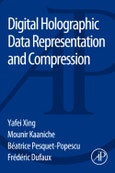With the increasing interest in holography for 3D imaging applications, there is a need to develop and use hologram compression techniques for the efficient storage and transmission of holographic data. This book gives a broad overview of the state-of-the-art techniques for the efficient compression and representation of digital holographic data, addressing both still and moving data sequences.
Please Note: This is an On Demand product, delivery may take up to 11 working days after payment has been received.
Table of Contents
1. Introduction
1.1. Overview of Digital Holography
1.2. Digital Holography System
2. Fundamental Principles of Digital Holography
2.1. Optical Theory
2.1.1. Interference
2.1.2. Diffraction
2.2. Computer Generated Hologram
2.2.1. Object Models
2.2.2. Mathematical Models
2.2.3. Speed-up Models
2.3. Representation of Digital Holographic Data
2.3.1. Intensity of Hologram
2.3.2. Complex Amplitude
3. Compression of Still Digital Holographic Data
3.1. Lossless Compression
3.1.1. Huffman Encoding
3.1.2. Lempel-Ziv Encoding
3.1.3. Burrows-Wheeler Encoding
3.2. Lossy Compression
3.2.1. Quality Evaluation Criteria
3.2.2. Quantization
3.2.3. Transform based Coding
3.2.4. 3D Scanning based Compression
3.2.5. Still Image Coding Standard-based Compression
4. Compression of Digital Holographic Sequences
4.1. Video Coding Standard-based Compression
4.1.1. MPEG-4 ASP
4.1.2. H.264/AVC
4.1.3. HEVC
4.2. Hybrid Compression
4.2.1. 3D Scanning based Compression
4.2.2. Vector lifting Scheme based Compression
5. Conclusions
Authors
Yafei Xing Institut Mines-Télécom, Télécom ParisTech, CNRS LTCI, Paris, France.Mounir Kaaniche
Béatrice Pesquet-Popescu Institut Mines-Télécom, Télécom ParisTech, CNRS LTCI, Paris, France.
Frédéric Dufaux Institut Mines-Télécom, Télécom ParisTech, CNRS LTCI, Paris, France.
Frédéric Dufaux is a CNRS Research Director at Telecom ParisTech. He is also Editor-in-Chief of Signal Processing: Image Communication.
Frédéric received his M.Sc. in physics and Ph.D. in electrical engineering from EPFL in 1990 and 1994 respectively. He has over 20 years of experience in research, previously holding positions at EPFL, Emitall Surveillance, Genimedia, Compaq, Digital Equipment, MIT, and Bell Labs. He has been involved in the standardization of digital video and imaging technologies, participating both in the MPEG and JPEG committees. He is the recipient of two ISO awards for his contributions. Frédéric was Vice General Chair of ICIP 2014. He is an elected member of the IEEE Image, Video, and Multidimensional Signal Processing (IVMSP) and Multimedia Signal Processing (MMSP) Technical Committees. He is also the Chair of the EURASIP Special Area Team on Visual Information Processing.
His research interests include image and video coding, distributed video coding, 3D video, high dynamic range imaging, visual quality assessment, video surveillance, privacy protection, image and video analysis, multimedia content search and retrieval, and video transmission over wireless network. He is the author or co-author of more than 120 research publications and holds 17 patents issued or pending.








